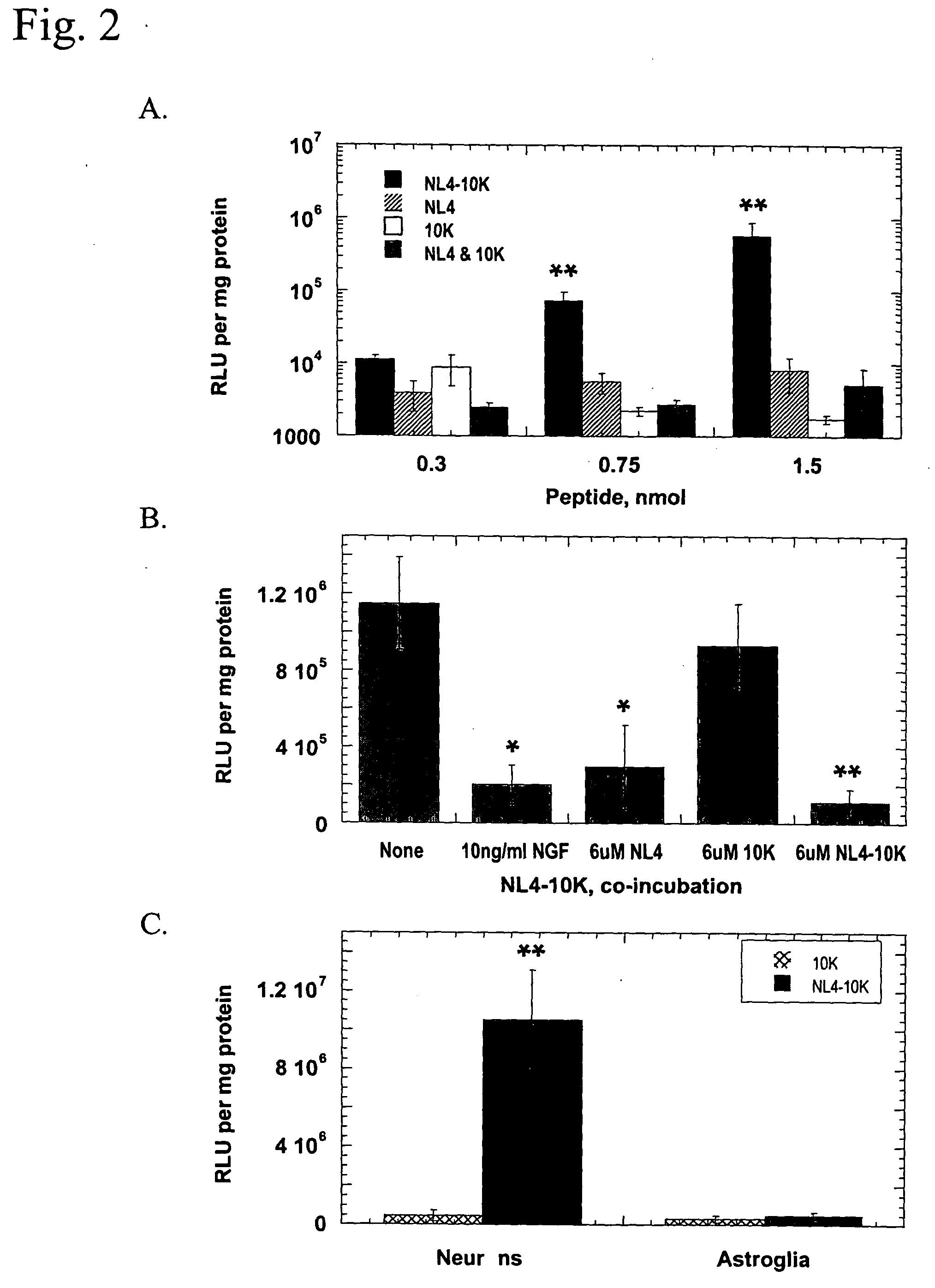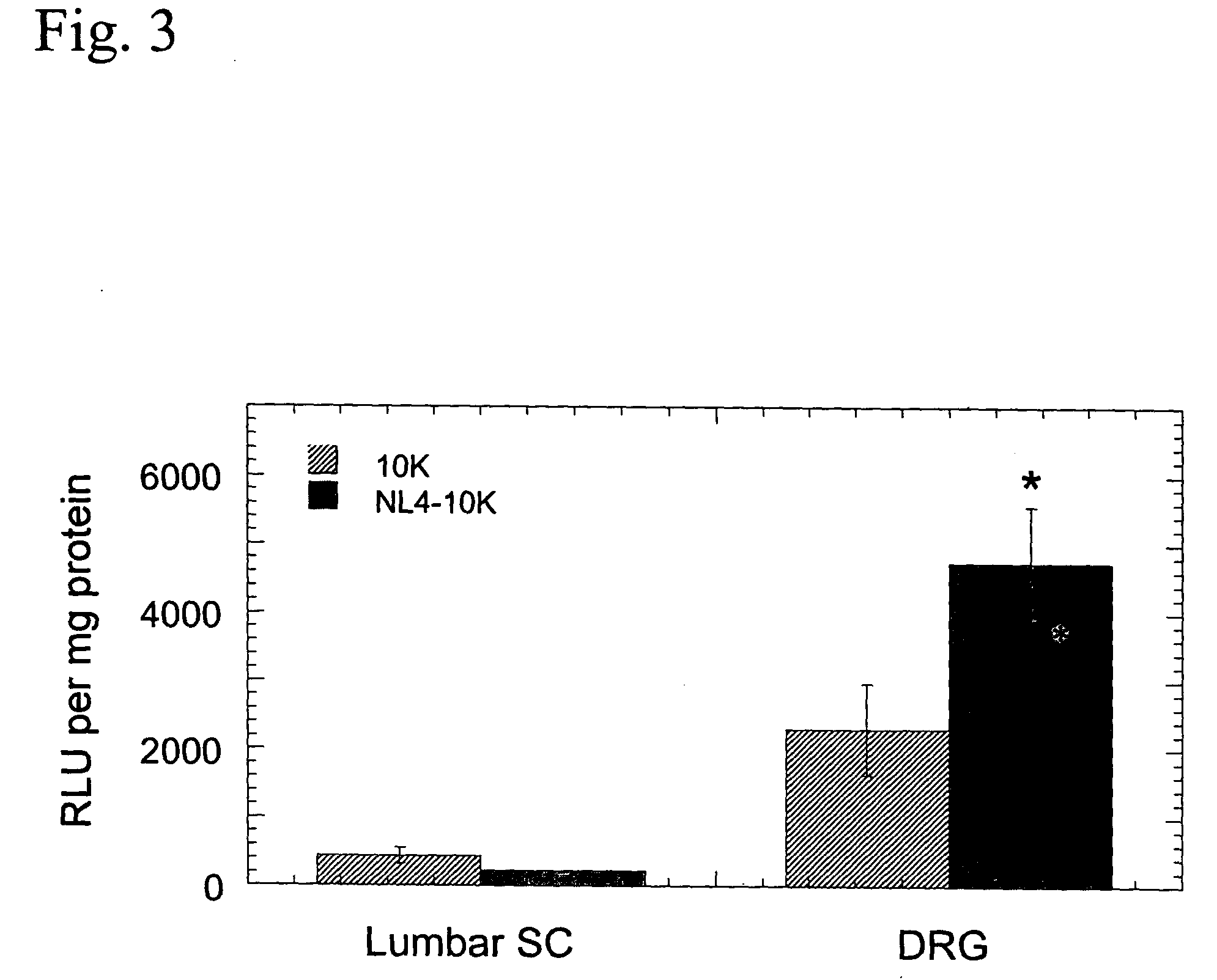Recombinant polypeptide useful for neurotrophin receptor mediated gene delivery and as neurotrophin agonist
a neurotrophin receptor and agonist technology, applied in the direction of peptide sources, botany apparatus and processes, immunoglobulins against cell receptors/antigens/surface determinants, etc., can solve the problems of low understanding of the target gene vector through receptor-ligand interaction to cells in a complex system, devastating effects on the individual, high social costs associated with chronic care and productivity loss, and inability to respond well to conventional therapeutic means. , the effect of improving transfected gen
- Summary
- Abstract
- Description
- Claims
- Application Information
AI Technical Summary
Benefits of technology
Problems solved by technology
Method used
Image
Examples
example 1
[0153] Design of NL4-10K
[0154] NL4-10K comprises loop 4 of NGF and the flanking .beta.-sheet sequences (NL4, amino acids 80-108) linked to a C-terminal nucleic acid binding domain of ten consecutive lysine residues (10K). The first and last amino acid residues of NL4 are cysteine residues, which form an intramolecular disulfide bond to stabilize the loop structure of the TrkA-binding region. The amino acid sequences of NL4-10K, NL4, and 10K are listed as SEQ ID NOS:5, 9 and 10), respectively.
[0155] Peptide Synthesis
[0156] NL4-10K, NL4, and 10K were chemically synthesized by conventional peptide synthesis techniques. NL4-10K and NL4 were synthesized, cyclized, and purified by Cambridge Research Biochemicals (Cleveland, UK). 10K was obtained from Bio-Synthesis (Lewisville, Tex., USA).
[0157] NL4-10K binds DNA
[0158] The ability of NL4-10K peptide to bind to DNA was monitored by DNA retardation during electrophoresis. Binding of NL4-10K to plasmid DNA reduces the charge-to-mass ratio of ...
example 2
[0169] 2.1 Design of DsbC-NL4-10K Recombinant Protein
[0170] In comparison to recombinantly produced proteins, peptide synthesis by chemical methods is expensive and faces chain-length limitations. We wish to show that the amino acid sequence of NL4-10K, when incorporated into a recombinant protein, retains its ability to mediate TrkA-targeted gene delivery. The chimeric protein DsbC-NL4-10K (SEQ ID NO:6) consists of NL4-10K attached to the C-terminus of DsbC, an E. coli disulfide bond isomerase that should enhance protein stability, solubility, and folding.
[0171] Plasmid Construction
[0172] The DNA sequence coding for NL4 was PCR-amplified from a pcDNA3.1 / GS plasmid containing the NGF gene (Invitrogen H-X52599M), using primers D1-a (SEQ ID NO:12) and D1-b (SEQ ID NO:13). The downstream primer, D1-b, includes in-frame codons for the 10K tail. This sequence was inserted in-frame into pET-40b(+) (Invitrogen) between the ScaI and HindIII sites, downstream of the coding sequences for DsbC...
example 3
[0180] Design of SPKR.sub.4NL1-2
[0181] SPKR.sub.4NL1-2 (SEQ ID NO:7) is a chimeric protein that contains a DNA-binding domain, SPKRSPKRSPKRSPKR (SEQ ID NO:11), near the N-terminus, linked to a targeting domain including loops 1 and 2 of NGF by an .alpha.-helical linker, TYLSEDELKAAEAAFKRHNPT (SEQ ID NO:30). The sequences of the histone H1-derived DNA-binding domain and the linker were first used by Fortunati et al. (Gene Therapy 2000; 7: 1505-15). The linker is flanked by flexible glycine residues and serves to allow independent action of the DNA-binding and targeting domains. The targeting domain comprises a Cys residue followed by aa 17-67 of human NGF, such that a disulfide bridge can form with the Cys residue corresponding to C58 in NGF. Based on the crystal structure of NGF (Wiesmann et al., Nature 1999; 401: 184-8), we judged that such a disulfide bond would help the targeting domain assume the native conformation of loops 1 and 2.
[0182] Plasmid Construction
[0183] For a prior ...
PUM
| Property | Measurement | Unit |
|---|---|---|
| volume | aaaaa | aaaaa |
| concentrations | aaaaa | aaaaa |
| concentrations | aaaaa | aaaaa |
Abstract
Description
Claims
Application Information
 Login to View More
Login to View More - R&D
- Intellectual Property
- Life Sciences
- Materials
- Tech Scout
- Unparalleled Data Quality
- Higher Quality Content
- 60% Fewer Hallucinations
Browse by: Latest US Patents, China's latest patents, Technical Efficacy Thesaurus, Application Domain, Technology Topic, Popular Technical Reports.
© 2025 PatSnap. All rights reserved.Legal|Privacy policy|Modern Slavery Act Transparency Statement|Sitemap|About US| Contact US: help@patsnap.com



